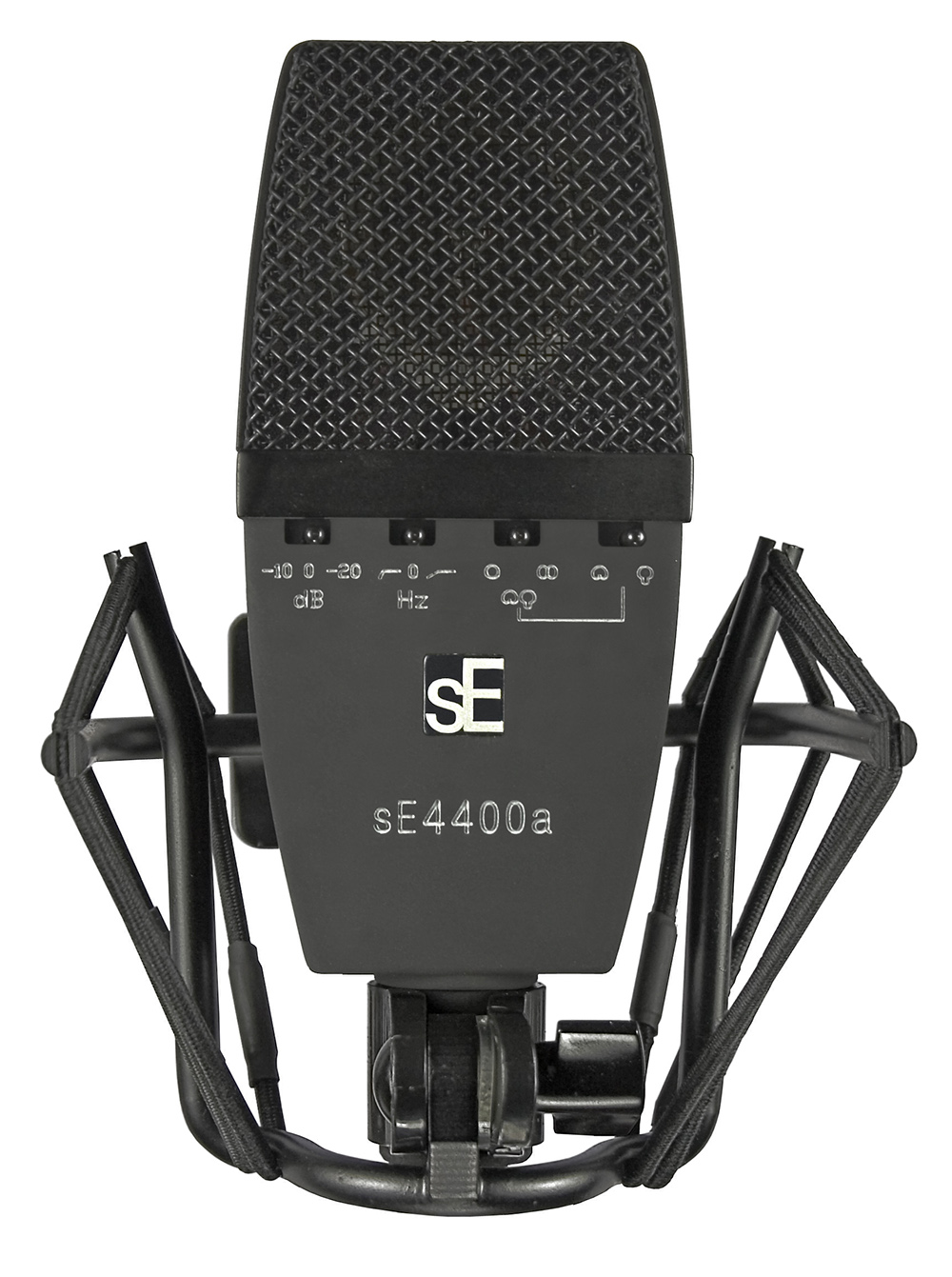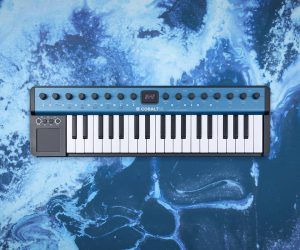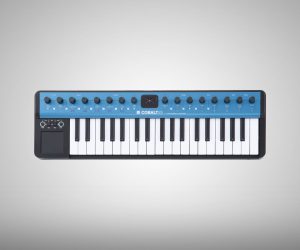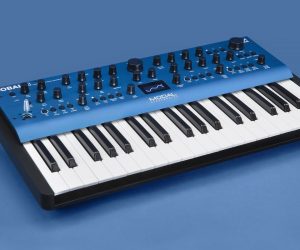
SE ELECTRONICS 4400A
If you still think all Chinese mics are ‘crap’ and walk around with a chip on your shoulder about it, now might be a good time to brush it off.
Text: Mark Woods
A few years ago I bought an sE Electronics Z3300A large diaphragm, multi-pattern microphone on eBay. I hadn’t heard one before but I liked the story of Siwei Zou; the Chinese oboe player/composer/conductor/studio-owner/businessman who spent time in the US before deciding to make export-quality microphones in a small factory in Shanghai. I’d read that sE mics were completely hand assembled to exacting tolerances with camera-style puffer brushes for dust control and a listening test for every mic before it left the factory. That’s how I want my microphones to be made, so I took a chance and bought one on spec. The Z3300A was great; as well as sending a present and sparkly sound into the control room, its physical presence was big and impressive for the customers to look at. It’s still in regular use at my studio as a general-purpose mic today and often gets first crack at breathy female vocals and stringed instrument overdubs.
In early 2009 I don’t think it’s overstating it to say that sE Electronics is a hit brand, not only for the design and quality of its microphones, but also thanks to the surprise success of its increasingly popular Reflexion Filter (which is designed to minimise the sometimes less than sympathetic room reflections of your recording booth/front bedroom). The 2009 release of a new range of mics developed in collaboration with Rupert Neve will no doubt only add to the company’s credibility. But without further ado, let’s get to the sE mic under scrutiny here…
The recently released one-inch dual-diaphragm, multi-pattern sE Electronics 4400A was developed – without Mr. Neve’s involvement – as a mid-level all-rounder suitable for professional or personal recording. According to sE, over a year was spent testing the mic in studios and with broadcasters before settling on the final capsule tuning. The supplied statistics of the finished product quote the boundaries of the 4400a’s frequency response as being 20Hz and 20kHz (no surprises there), with a maximum SPL of 130dB (at 0.5% THD) and a quiet 17dB equivalent noise level.
Previous sE large-diaphragm mics had a distinct family look: modern design, big bodies to house the large diaphragm condensers, matte silver colour schemes and big shockmounts. Not so the 4400a. Out of the case, this thin, light, surprisingly small AKG C-414-styled microphone is well and truly the black sheep of the family. The body is moulded; a first for sE, which previously used metal-tube based designs. It’s very black, with a rubberised non-reflective finish that feels good to the touch and keeps the mic unobtrusive, especially under lights. On the front, and easy to see, are four of the common short-stemmed switches for the various microphone controls. These include two pads: either –10dB or –20dB and two high-pass filters rolling out bottom end from either 60Hz or 120Hz. Pattern switching is between omni, figure eight, cardioid or super cardioid.
The supplied case of the 4400a is quite large and strong enough to protect the mic from even the roughest treatment – although I never actually dropped the mic out of a moving car to prove this theory… The shockmount is almost too clever in its design, allowing the mic to be placed either inside the mount for normal use or outside the mount for close use and/or accessing tight spaces. It can also protrude from the mount and swivel around so it can be used inside a bass drum, hidden among percussion or flat on toms, although I’m not sure I’d use it on toms – in all likelihood it would sound great, but it only takes one hit from a drum stick to make a mess of a nice condenser microphone.
FLYING OVERHEAD
Overheads are usually safe, though, and my first test of the sE 4400a was above the drum kit for a live band. Like most large-diaphragm condensers, the 4400a isn’t really designed as a live mic but for me it’s a good way of getting a first impression of a microphone’s overall performance. Placed fairly high above the drummer’s head, the 4400a provided a clear view of the whole kit with bright cymbals and plenty of body from the toms. It was also used on percussion with Slava Grigoryan and the Band of Brothers when I mixed them live recently, and here the 4400a contributed nicely to the performance with a sound that was detailed, appealing and dynamically accurate.
From hearing it live I knew the 4400a would sound good in the studio. In comparison with my usual large-diaphragm condenser mics, all of which were initially set to cardioid, the sE 4400a displayed a smooth high-midrange with lots of presence above 5kHz but very little noticeable harshness. The low-mids were surprisingly strong offering a valve-mic style richness to the sound. Down low, the mic produces the usual proximity effect but the 120Hz roll-off does a good job of controlling this if required. Plosives on the 4400a meanwhile are easy to induce and a pop shield is definitely requisite equipment for any close vocal performances.
Moving around the mic I was particularly impressed by the off-axis response in the sE’s cardioid patterns. The response is even across the front of the mic and then drops off in level, maintaining a pleasing quality all the way to the rear. The omni-directional polar pattern gives a different presence to the sound; it’s airy compared to a cardioid setup (as omnis so often are) but still remains close and very natural sounding. In the figure-eight position the mic displayed strong rejection at 90 degrees with tight and uncompromised pick-up lobes. The response from the front was slightly different to the back though, and in a listening test it was fairly easy to identify the source side of the mic.
Recording tests started with drums. Here the 4400a’s brightness, combined with its off-axis response, produced great results initially above a kit and later on as a room mic. It didn’t seem to mind the volume in close proximity to the skin drums either – provided the –20dB pad was switched in – and in this position the 4400a delivered a big fat snare sound. I tried it on a kick drum, and yes, it will fit right inside the drum through a normal-sized hole in the skin. Again, the –20dB pad was required to prevent overloading but the sound was good – accurate, and providing plenty of depth with minimal boom.
NOT VERY ‘SE’
By now I was convinced of the 4400’s overall ability and started using it on everything I could, looking forward to how it would sound. Acoustic guitars sounded open and true and I’m sure it would work well on other stringed instruments – I was hoping someone would bring in a banjo to a session while I had my hands on the mic, but alas… Vocals were a pleasure too; the 4400a’s combination of body and smooth top end worked well on both male and female vocals. There’s plenty of rich low-mids for the blokes but it’s bright and airy when required, without ever exacerbating sibilance. It doesn’t start to bite with harshness on the louder moments of a performance either, and all the finished vocals I recorded with the 4400a sat clearly in their requisite mixes without needing EQ.
Although my focus is on sound reinforcement and music recording, I can also see this mic becoming popular for film, theatre and TV applications. The sE 4400a is designed to work well under the glare of lights and its positioning flexibility, small size and excellent off-axis response would no doubt help to deliver great results when used for production or location recording.
GREAT EXPECTATIONS
Some mics you use because you want the sound you expect they will deliver. Others you use to find out what sound they will give you. The sE 4400a is one of the latter; it’s accurate but also flattering… and these are both valuable attributes. If you only had the proverbial one microphone in your drawer you’d be fine with the sE 4400a. If you were allowed two mics in the drawer they’re also available in matched stereo pairs with an optional stereo bar mount! As you may have already guessed, I’ve been very impressed with the sE 4400a – well worthy of serious consideration for anyone looking to buy a solid performer.

















RESPONSES